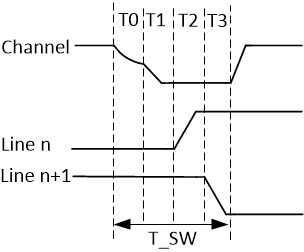SLVSG10D November 2021 – July 2022 TLC6984
PRODUCTION DATA
- 1 Features
- 2 Applications
- 3 Description
- 4 Revision History
- 5 Description (continued)
- 6 Pin Configuration and Functions
- 7 Specifications
-
8 Detailed Description
- 8.1 Overview
- 8.2 Functional Block Diagram
- 8.3
Feature Description
- 8.3.1 Independent and Stackable Mode
- 8.3.2 Current Setting
- 8.3.3 Frequency Multiplier
- 8.3.4 Line Transitioning Sequence
- 8.3.5 Protections and Diagnostics
- 8.4 Device Functional Modes
- 8.5 Continuous Clock Series Interface
- 8.6 PWM Grayscale Control
- 8.7 Register Maps
- 9 Application and Implementation
- 10Power Supply Recommendations
- 11Layout
- 12Device and Documentation Support
- 13Mechanical, Packaging, and Orderable Information
Package Options
Mechanical Data (Package|Pins)
Thermal pad, mechanical data (Package|Pins)
Orderable Information
8.3.4 Line Transitioning Sequence
The TLC6984 defines a timing sequence of scan line transition, shown as Figure 8-7. T_SW is the total transitioning time. T_SW is broken up into four intervals: T0 is the time interval between the end of PWM time in current segment and the beginning of channel pre-discharge, T1 is the time interval between the beginning of the channel pre-discharge and the beginning of current line OFF, T2 is the time interval that the beginning of current line OFF and the beginning of next line ON, T3 is the time interval of the beginning of next line ON and the beginning of PWM time in next segment.
 Figure 8-7 Line
Transitioning Sequence
Figure 8-7 Line
Transitioning SequenceThe line switch time T_SW equals to T0 + T1 + T2 + T3. T_SW can be configured by the LINE_SWT (see FC1 register bit 40-37 in FC1).
Table 8-4 is the relation between LINE_SWT bits and the line switch time (GCLK numbers) with different internal GCLK frequency.
| LINE_SWT | GCLK Numbers | T_SW (us, 40-MHZ GCLK) | T_SW (us, 60-MHZ GCLK) | T_SW (us, 100-MHZ GCLK) | T_SW (us, 120-MHZ GCLK) | T_SW (us, 160-MHZ GCLK) |
|---|---|---|---|---|---|---|
| 0000b | 45 | 1.125 | 0.7515 | 0.45 | 0.3735 | 0.2835 |
| 0001b | 60 | 1.5 | 1.002 | 0.6 | 0.498 | 0.378 |
| 0010b | 90 | 2.25 | 1.503 | 0.9 | 0.747 | 0.567 |
| 0011b | 120 | 3 | 2.004 | 1.2 | 0.996 | 0.756 |
| 0100b | 150 | 3.75 | 2.505 | 1.5 | 1.245 | 0.945 |
| 0101b | 180 | 4.5 | 3.006 | 1.8 | 1.494 | 1.134 |
| 0110b | 210 | 5.25 | 3.507 | 2.1 | 1.743 | 1.323 |
| 0111b | 240 | 6 | 4.008 | 2.4 | 1.992 | 1.512 |
| 1000b | 270 | 6.75 | 4.509 | 2.7 | 2.241 | 1.701 |
| 1001b | 300 | 7.5 | 5.01 | 3 | 2.49 | 1.89 |
| 1010b | 330 | 8.25 | 5.511 | 3.3 | 2.739 | 2.079 |
| 1011b | 360 | 9 | 6.012 | 3.6 | 2.988 | 2.268 |
| 1100b | 390 | 9.75 | 6.513 | 3.9 | 3.237 | 2.457 |
| 1101b | 420 | 10.5 | 7.014 | 4.2 | 3.486 | 2.646 |
| 1110b | 450 | 11.25 | 7.515 | 4.5 | 3.735 | 2.835 |
| 1111b | 480 | 12 | 8.016 | 4.8 | 3.984 | 3.024 |